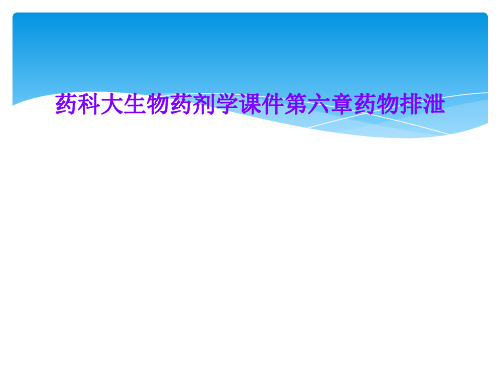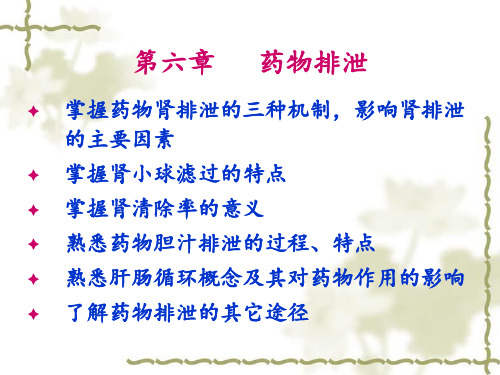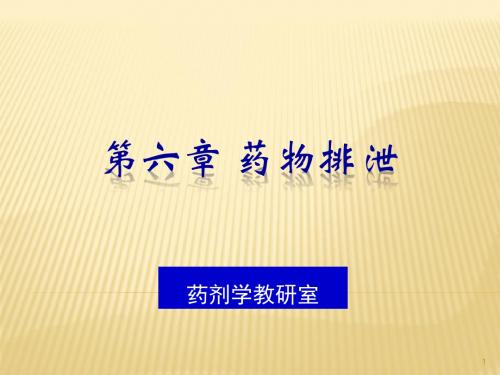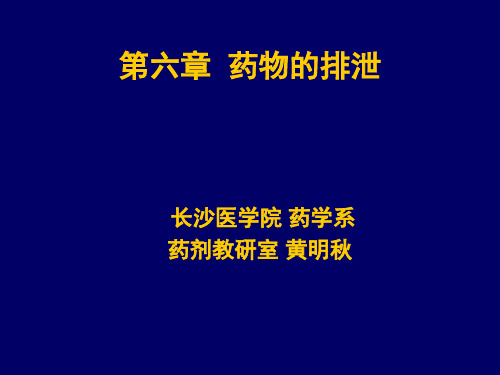药科大生物药剂学课件第六章药物排泄
合集下载
第六章_药物的排泄详解

胆汁/血浆比率为1:如氯化钠、葡萄糖 胆汁/血浆比率为小于1:如血浆蛋白 胆汁/血浆比率为大于1:如胆红素和胆盐
对于胆汁/血浆浓度高的药物,胆汁排泄是其 重要排泄途径。
药物胆汁排泄特点:
以主动分泌为主,也有被动扩散过程。 药物胆汁排泄需具备以下几个条件:
药物是极性物质 分子量超过300,小于5000. 例如: 葡糖醛酸、硫酸或甘氨酸的结合物等,分子中有 强极性基团,且分子量在300以上的物质,胆汁排泄 率较高。
可经肾小球滤过。
药物与血浆蛋白结合后, 不能被滤过。
肾小球滤过率(GFR)
单位时间肾小球滤过的血浆体积数(ml/min),即单 位时间形成的原尿量。 正常生理情况下,肾小球滤过 率约为125ml/min.
反映肾小球滤过作用的大小。
某些疾病状态下或肾功能不全时,GFR常常降低。
二、肾小管主动分泌
指肾在单位时间内完全清除所含药物的血浆体积数 (ml/min) 。
定量描述肾对不同药物的清除能力。
肾清除率的计算
Clr • C= V • U Clr = V • U /C
其中,V为每分钟的尿量,U为尿中药物浓度, C为血浆中药物浓度。
肾清除率与肾小球滤过率的关系:
1.肾清除率=肾小球滤过率 既无肾小管分泌,也无重吸收(如:菊粉125ml/min)。
季铵类药物脂溶性小,几乎不被吸收。
多数药物代谢产物水溶性变大,重吸收减少,利 于排出。
(2) 尿pH值 尿液的pH值会影响弱酸或弱碱性药物的解离度,从
而影响其吸收。
能使尿液的 pH上升至8
临床对苯巴比妥与水杨酸类药物中毒时给予 NaHCO3,使尿液碱化,加速其排泄;对弱碱性药 物如阿托品、度冷丁等中毒时则选用NH4CL,使 尿液酸化,加速其排泄。
对于胆汁/血浆浓度高的药物,胆汁排泄是其 重要排泄途径。
药物胆汁排泄特点:
以主动分泌为主,也有被动扩散过程。 药物胆汁排泄需具备以下几个条件:
药物是极性物质 分子量超过300,小于5000. 例如: 葡糖醛酸、硫酸或甘氨酸的结合物等,分子中有 强极性基团,且分子量在300以上的物质,胆汁排泄 率较高。
可经肾小球滤过。
药物与血浆蛋白结合后, 不能被滤过。
肾小球滤过率(GFR)
单位时间肾小球滤过的血浆体积数(ml/min),即单 位时间形成的原尿量。 正常生理情况下,肾小球滤过 率约为125ml/min.
反映肾小球滤过作用的大小。
某些疾病状态下或肾功能不全时,GFR常常降低。
二、肾小管主动分泌
指肾在单位时间内完全清除所含药物的血浆体积数 (ml/min) 。
定量描述肾对不同药物的清除能力。
肾清除率的计算
Clr • C= V • U Clr = V • U /C
其中,V为每分钟的尿量,U为尿中药物浓度, C为血浆中药物浓度。
肾清除率与肾小球滤过率的关系:
1.肾清除率=肾小球滤过率 既无肾小管分泌,也无重吸收(如:菊粉125ml/min)。
季铵类药物脂溶性小,几乎不被吸收。
多数药物代谢产物水溶性变大,重吸收减少,利 于排出。
(2) 尿pH值 尿液的pH值会影响弱酸或弱碱性药物的解离度,从
而影响其吸收。
能使尿液的 pH上升至8
临床对苯巴比妥与水杨酸类药物中毒时给予 NaHCO3,使尿液碱化,加速其排泄;对弱碱性药 物如阿托品、度冷丁等中毒时则选用NH4CL,使 尿液酸化,加速其排泄。
(生物药剂学)第六章药物排泄

药物排泄过程的正常与否关系到药物 在体内的浓度和持续时间,从而严重影 响到药物的作用。
排泄途径
一.肾脏排泄 二.胆汁排泄 三.唾液排泄 四.乳汁分泌 五.汗液 六.肺
第一节 药物的肾排泄
肾的解剖结构
肾单位的基本功能
➢ 肾小球是动静脉交汇的毛细血管团,这部分 毛细血管血压较其它部位高,又有较大的微 孔,因此除血球和蛋白外等高分子外,一般 物质都可滤过,输入肾小管。
药物代谢
药物经代谢后,大多水溶性增 加,肾小管重吸收下降,有利于从 肾脏排出。 但甲基化和乙酰化反应可使 代谢物极性下降,不利于药物的 排泄。
pH对磺胺类清除的影响很显著
尿pH值由5上升到8, 磺胺乙噻二唑(弱酸 药物)在人体中生物 半衰期由11.4减少 到4.2小时。
服用碳酸氢钠后, 磺胺乙噻二唑(弱酸 药物)消除速率是原 来的2倍。
尿量
由于是被动转运,重吸收速率依赖于肾
小管内液的药物浓度。
尿量增加时,药物浓度下降,减少重吸
第六章 药物排泄
本章要求
1、掌握药物肾排泄的三种机制,影响肾排泄的主要因素; 2、掌握肾小球滤过的特点; 3、掌握肾清除率的意义及对药物作用的影响; 4、熟悉药物胆汁排泄过程及药物胆汁排泄的特征; 5、掌握肠肝循环概念及对药物作用的影响; 6、了解药物排泄的其他途径。
药物排泄
药物排泄:体内药物或代谢物排出体 外的过程。
点时间的血药浓度。 每分钟尿药排泄量 = 血浆药浓×肾清除率
Clr
dXu / dt C
通过肾清除率可推测药物的排泄机制
设血浆中未结合药物比例分数为fu,药物肾小球滤过率为 fu ·GFR
o 若Clr = fu ·GFR ,仅有肾小球滤过
o 若Clr > fu ·GFR ,除肾小球滤过外,还存在肾小管分泌,或 肾小管分泌 > 重吸收
排泄途径
一.肾脏排泄 二.胆汁排泄 三.唾液排泄 四.乳汁分泌 五.汗液 六.肺
第一节 药物的肾排泄
肾的解剖结构
肾单位的基本功能
➢ 肾小球是动静脉交汇的毛细血管团,这部分 毛细血管血压较其它部位高,又有较大的微 孔,因此除血球和蛋白外等高分子外,一般 物质都可滤过,输入肾小管。
药物代谢
药物经代谢后,大多水溶性增 加,肾小管重吸收下降,有利于从 肾脏排出。 但甲基化和乙酰化反应可使 代谢物极性下降,不利于药物的 排泄。
pH对磺胺类清除的影响很显著
尿pH值由5上升到8, 磺胺乙噻二唑(弱酸 药物)在人体中生物 半衰期由11.4减少 到4.2小时。
服用碳酸氢钠后, 磺胺乙噻二唑(弱酸 药物)消除速率是原 来的2倍。
尿量
由于是被动转运,重吸收速率依赖于肾
小管内液的药物浓度。
尿量增加时,药物浓度下降,减少重吸
第六章 药物排泄
本章要求
1、掌握药物肾排泄的三种机制,影响肾排泄的主要因素; 2、掌握肾小球滤过的特点; 3、掌握肾清除率的意义及对药物作用的影响; 4、熟悉药物胆汁排泄过程及药物胆汁排泄的特征; 5、掌握肠肝循环概念及对药物作用的影响; 6、了解药物排泄的其他途径。
药物排泄
药物排泄:体内药物或代谢物排出体 外的过程。
点时间的血药浓度。 每分钟尿药排泄量 = 血浆药浓×肾清除率
Clr
dXu / dt C
通过肾清除率可推测药物的排泄机制
设血浆中未结合药物比例分数为fu,药物肾小球滤过率为 fu ·GFR
o 若Clr = fu ·GFR ,仅有肾小球滤过
o 若Clr > fu ·GFR ,除肾小球滤过外,还存在肾小管分泌,或 肾小管分泌 > 重吸收
药科大生物药剂学课件第六章药物排泄

What happens to a drug after its administration ? (“fate of a drug”)
Absorption Distribution Metabolism Excretion
Metabolism + Excretion = Elimination
第一节 概 述
药科大生物药剂学课件第六章药物排泄
主要内容
❖ 概述 ❖ 药物的肾排泄 ❖ 药物的胆汁排泄 ❖ 药物的其它途径排泄
学习目标与基本要求
掌握药物排泄的定义与意义 掌握药物经肾排泄的过程与机理;掌握肾清除
率的概念和意义 掌握的肾排泄的主要器官及肾脏的机构与机理 熟悉药物的胆汁排泄和肠肝循环 了解药物其它途径排泄的意义和作用
血液透析( Hemodialysis)
血液透析( Hemodialysis)
该技术对于符合下列条件的药物具有重要意义: 1) good water solubility; 2) not tightly bound to plasma
protein; 3) smaller (< 500) molecular weight; 4) a small apparent volume of
to high concentration • exists competitive inhibition • exists saturation phenomenon • the rate of plasma protein binding
don’t effects the rate of drug
肠肝循环使得胆汁排泄重要!
第三节 药物的胆汁排泄
胆汁排放途径: 肝细胞分泌胆汁→毛细胆管→小叶间胆管→左右胆管→肝总管
《生物药剂学》第六章 药物排泄 ppt课件

肾清除率( Clr, renal clearane):
在单位时间内,被肾脏完全清除的某物质的血 浆容积数称为肾脏排泄血浆清除率,简称为肾清 除率。 Clr = U • V / P (ml/min) 与肾小球滤过率的关系(推测药物排泄机制)
Clr = fu∙GFR 仅有肾小球滤过 Clr < fu∙GFR 有肾小管重吸收 Clr > fu∙GFR 有肾小管分泌
影响胆汁排泄的因素
• 药物理化性质
极性 :极性 ↑ ,胆汁排泄↑(葡萄糖醛酸 结合物、 谷胱甘肽结合物) 分子量(300~5000) • 生理因素 种属、年龄、代谢状况、蛋白结合率、胆汁流量、 疾病等
肠肝循环(enterohepatic cycle)
胆汁中排泄的药物或其代谢物在小肠中 重新被吸收的现象
➢ 主动重吸收(近曲小管)
内源性物质(葡萄糖,电解质、 氨基酸、维生素等)
➢ 被动重吸收(远曲小管)
外源性物质(如药物)Βιβλιοθήκη 肾小管主动分泌(近曲小管)
指药物由血管一侧通过上皮细胞侧底膜摄入 细胞,再从细胞内通过刷状膜向管腔一侧 流出。
✓ 有机酸— 阴离子分泌机制 (对氨基马尿酸、青霉素G、磺胺类等)
✓ 有机碱— 阳离子分泌机制 (多巴胺、普鲁卡因、胆碱等)
生物半衰期长,血药浓度有时出现双峰 (己烯雌酚、强心苷类、 吲哚美辛、华法林、 吗啡、螺内酯等)
第三节 药物的其他排泄途径
• 乳汁 • 唾液 •肺 • 汗腺
一、药物从乳汁排泄
大多药物能从乳汁排出,并能在乳汁中测出药 物浓度。
一般药物在乳汁中的浓度低,在乳汁中排出量 不足以引起婴儿的治疗效应。
有些药物从乳汁排出较大,如红霉素、卡马西平、 地西泮和巴比妥酸盐等。
药物排泄ppt课件

运用动力学原理(kinetics)与数学方法,定量地描述药物通 过各种途径(如静脉注射,静脉滴注,口服给药等)进 入机体内的吸收(Absorption) 、分布(Distribution)、代 谢(Metabolism)和排泄(Elimination), (即ADME)等过 程的“血药浓度经时”动态变化规律。
整理版课件
27
2.肠肝循环(enterohepatic circulation)
药物 肝脏 胆囊 小肠
药物在肝 脏与葡萄 糖等结合
整理版课件
药物在肠 道被水解
28
有肠肝循环的药物
强心甙类如地高辛和洋地黄毒甙、吲垛美辛、吗 啡、苯妥英钠、己烯雌酚、六氯酚、酚酞、美 沙酮、螺旋内酯、阿霉素、华法林和氯丙嗪等。 这些药物多数以葡萄糖醛酸结合物排泄。
第六章 药物的排泄 (excretion)
药学院药剂教研室 高秀蓉
整理版课件
1
药物的排泄(excretion)
是指药物及其代谢产物排出体外的过程。
整理版课件
2
药物自体内排泄的途径:
肾排泄
非肾排泄
胆汁排泄
药物从唾液、乳汁、 汗腺、肺中排泄
整理版课件
3
第一节 药物的肾排泄
整理版课件
4
肾排泄
肾脏结构示意图
42
2.双室模型 一些部位达平衡快,一些部位慢。
中央 室
周边室
整理版课件
43
X X X0
K12
CHale Waihona Puke K21PK10整理版课件
44
总之,隔室是以速度论的观点划分的, 即以药物分布的速度来划分,具有抽象 意义而不具解剖学的意义。不同于生理 药物动力学模型。
整理版课件
27
2.肠肝循环(enterohepatic circulation)
药物 肝脏 胆囊 小肠
药物在肝 脏与葡萄 糖等结合
整理版课件
药物在肠 道被水解
28
有肠肝循环的药物
强心甙类如地高辛和洋地黄毒甙、吲垛美辛、吗 啡、苯妥英钠、己烯雌酚、六氯酚、酚酞、美 沙酮、螺旋内酯、阿霉素、华法林和氯丙嗪等。 这些药物多数以葡萄糖醛酸结合物排泄。
第六章 药物的排泄 (excretion)
药学院药剂教研室 高秀蓉
整理版课件
1
药物的排泄(excretion)
是指药物及其代谢产物排出体外的过程。
整理版课件
2
药物自体内排泄的途径:
肾排泄
非肾排泄
胆汁排泄
药物从唾液、乳汁、 汗腺、肺中排泄
整理版课件
3
第一节 药物的肾排泄
整理版课件
4
肾排泄
肾脏结构示意图
42
2.双室模型 一些部位达平衡快,一些部位慢。
中央 室
周边室
整理版课件
43
X X X0
K12
CHale Waihona Puke K21PK10整理版课件
44
总之,隔室是以速度论的观点划分的, 即以药物分布的速度来划分,具有抽象 意义而不具解剖学的意义。不同于生理 药物动力学模型。
生物药剂学第六章 药物排泄

一、生理因素
(二)胆汁流量: ➢ 高蛋白和高脂肪的食物能引起胆汁的大量分泌和排出,而
碳水化合物类食物的作用较小。 ➢ 进食之后,迷走神经兴奋,是胆汁大量流入十二指肠 ➢ 胆囊收缩素引起胆囊的强烈收缩和括约肌的扩展 ➢ 促进激素刺激肝细胞分泌胆汁。 ➢ 胆汁量增加时,随其进入肠道内的药物量均增加。
一、生理因素
因素:药物的脂溶性、pKa、蛋白结合率、唾液pH等 ➢ 以唾液代替血浆样品,进行药物动力学研究。 ➢ 主动转运:锂。
三、药物从肺部的排泄
➢ 共同特性:分子量较小,沸点较低 ➢ 影响因素:肺部的血流量、呼吸的频率、挥
发性药物的溶解性等。
四、药物从汗腺和毛发的排泄
➢ 汗腺排泄主要依赖于药物分子型的被动扩散 ➢ 毛发中只有微量的药物排泄:汞和砷
➢ 也可以采用离体法:离体肾灌流技术
第二节 药物的胆汁排泄
第二节 药物的胆汁排泄
➢ 胆汁排泄是肾之外排泄中最主要的途径 ➢ 维生素A、D、E、B12、性激素、甲状腺素及这些
物质的代谢产物胆汁中排泄非常显著。 ➢ 高胆汁清除的药物具有的特点:能主动分泌;药物
是极性物质;相对分子量超过300
一、药物胆汁排泄的过程与特征
该药肾清除率等于肾小球的滤过率,值为125mL/min。 ➢ 若肾清除率低于fuxGFR,则表示从肾小球滤过后有一定的
肾小管重吸收。 ➢ 若高于该值,则表示除肾小球滤过外,分泌>重吸收
五、研究药物肾排泄的方法
➢ 多采用在体外法或体内法,对象是人或动物,通常 是在给药后不同时间收集尿样,记录尿量,测定尿 量浓度,计算累计排泄量,直至排泄完成。
第六章 药物排泄
Excretion
学习目标
1、熟悉药物排泄的特点 2、掌握药物肾排泄的机制和影响肾排泄的主要因素 3、掌握药物胆汁排泄的过程和影响药物胆汁排泄的因素 4、熟悉肝肠循环概念及对药物作用的影响 5、了解药物的其他排泄途径
最新第六章 药物的排泄 长沙医学院幻灯片课件

阳离子转运系统
为许多有机胺类化合物所拥有的肾分泌 排泄机制,代表物质为N-甲基烟酰胺,吗 啡等。
肾排泄率= (1-FR)( 分 泌 率 + 滤 过 率 )
E.随尿液排泄
影响肾排泄因素
1. 药物脂溶性 2. 血浆蛋白结合率 3. 尿液pH与尿量 4. 合并用药 5. 药物代谢 6. 肾脏疾病:肾小球肾炎会使肾小球滤过率
➢ 肾小球的滤过
肾小球毛细血管内血压高,管壁上微孔较 大(7-10 nm),故除血球和蛋白质外的 一般物质均可无选择性地滤过。
药物以膜孔扩散方式滤过,滤过率较高, 但与血浆蛋白结合的药物不能被滤过。
➢ 肾小球的滤过 肾脏血流量为1200 mL/min 肾小球的滤过率(GFR)125mL/min
➢ 肾小管重吸收
肝细胞膜和肝内的窦状隙的内壁上都有 许多微孔,药物透过这种微孔的速度受分子 量大小影响。
主动转运
有些药物由血液向胆汁的转运存在着主动转运 机制,因此药物浓度显著高于血浆中的浓度。
主动转运系统: ①有机酸 ②有机碱 ③中性化合物 ④胆酸及胆盐 ⑤重金属
特点: ①饱和现象; ②逆浓度梯度转运; ③竞争性抑制; ④受代谢抑制剂的抑制。
律师事务所——
•律师事务所设立在县以上的层区 •律师事务所是律师的执业机构 •有自己的名称、住所、章程 •有10万元以上的人民币资产 •有符合《律师法》规定的专业律师
公证处——
•公证员能够依据法律和事实,证明合 同、遗嘱、亲属关系、身份、学历、 出生日期、婚姻状况等的真实性、小杰记得书上说过有事 可以找警察帮忙,于是向人打听哪里能找 到警察。终于找到了一间派出所。
民警把小杰送回了他的父母身边。还 根据小杰提供的线索捉获了拐骗他的人贩 子。
为许多有机胺类化合物所拥有的肾分泌 排泄机制,代表物质为N-甲基烟酰胺,吗 啡等。
肾排泄率= (1-FR)( 分 泌 率 + 滤 过 率 )
E.随尿液排泄
影响肾排泄因素
1. 药物脂溶性 2. 血浆蛋白结合率 3. 尿液pH与尿量 4. 合并用药 5. 药物代谢 6. 肾脏疾病:肾小球肾炎会使肾小球滤过率
➢ 肾小球的滤过
肾小球毛细血管内血压高,管壁上微孔较 大(7-10 nm),故除血球和蛋白质外的 一般物质均可无选择性地滤过。
药物以膜孔扩散方式滤过,滤过率较高, 但与血浆蛋白结合的药物不能被滤过。
➢ 肾小球的滤过 肾脏血流量为1200 mL/min 肾小球的滤过率(GFR)125mL/min
➢ 肾小管重吸收
肝细胞膜和肝内的窦状隙的内壁上都有 许多微孔,药物透过这种微孔的速度受分子 量大小影响。
主动转运
有些药物由血液向胆汁的转运存在着主动转运 机制,因此药物浓度显著高于血浆中的浓度。
主动转运系统: ①有机酸 ②有机碱 ③中性化合物 ④胆酸及胆盐 ⑤重金属
特点: ①饱和现象; ②逆浓度梯度转运; ③竞争性抑制; ④受代谢抑制剂的抑制。
律师事务所——
•律师事务所设立在县以上的层区 •律师事务所是律师的执业机构 •有自己的名称、住所、章程 •有10万元以上的人民币资产 •有符合《律师法》规定的专业律师
公证处——
•公证员能够依据法律和事实,证明合 同、遗嘱、亲属关系、身份、学历、 出生日期、婚姻状况等的真实性、小杰记得书上说过有事 可以找警察帮忙,于是向人打听哪里能找 到警察。终于找到了一间派出所。
民警把小杰送回了他的父母身边。还 根据小杰提供的线索捉获了拐骗他的人贩 子。
药物排泄ppt课件

18
主动转运 (内源性物质:
重吸收机制
维生素、电解质、糖及氨基酸)
被动扩散 (外源性物质:药物)
取 决 于
药物的脂溶性、pKa、尿量和尿的pH值
重吸收符合pH-分配假说,脂溶性、非解离型药物 重吸收程度大。
19
1、药物的脂溶性
脂溶性大的非解离型药物重吸收程度大。 多数药物经体内代谢后,变成极性大的水溶性
27
3、尿量
例1:应用甘露醇等利尿剂来增加尿量而促进某些药 物的排泄,以达解毒的目的。
原因:甘露醇可被肾小球滤过而不能被肾小管重吸收,因此 提高了小管液中溶质浓度,引起尿量增多,这种利尿方式称 渗透性利尿。故甘露醇可作为利尿药应用于临床。
例2:碳酸氢钠能解救苯巴比妥中毒,并用利尿药可 缩短解毒时间。
代谢物,使肾小管重吸收减少。 例:磺胺类药物
20
长效磺胺
磺胺的脂溶性和肾小管的重吸收
21
2、尿的pH值和药物的pKa值
尿液的pH约6.3,可在4.5~8.0变化。 弱酸、弱碱性药物的重吸收依赖于尿液的pH和药物的
pKa。 Henderson-Hasselbalch公式: 弱酸: pKa – pH = lg ( [HA] / [A-] )
24
25
3、尿量
小管液中溶质浓度形成的渗透压是对抗肾小管重吸 收水分的力量。
小管液中溶质浓度 渗透压水的重吸收 尿量
如:糖尿病患者的血糖浓度升高,肾小管不能将葡萄 糖完全吸收回血,小管液中葡萄糖含量增多,小管液 渗透压增高,重吸收减少而引起多尿。
26
3、尿量 对于被动吸收,转运速度与药浓成正比。 当尿量,肾小管腔中的药浓,重吸收
43
影响因素:
o 药物的浓度梯度 血浆中游离药浓,转运
主动转运 (内源性物质:
重吸收机制
维生素、电解质、糖及氨基酸)
被动扩散 (外源性物质:药物)
取 决 于
药物的脂溶性、pKa、尿量和尿的pH值
重吸收符合pH-分配假说,脂溶性、非解离型药物 重吸收程度大。
19
1、药物的脂溶性
脂溶性大的非解离型药物重吸收程度大。 多数药物经体内代谢后,变成极性大的水溶性
27
3、尿量
例1:应用甘露醇等利尿剂来增加尿量而促进某些药 物的排泄,以达解毒的目的。
原因:甘露醇可被肾小球滤过而不能被肾小管重吸收,因此 提高了小管液中溶质浓度,引起尿量增多,这种利尿方式称 渗透性利尿。故甘露醇可作为利尿药应用于临床。
例2:碳酸氢钠能解救苯巴比妥中毒,并用利尿药可 缩短解毒时间。
代谢物,使肾小管重吸收减少。 例:磺胺类药物
20
长效磺胺
磺胺的脂溶性和肾小管的重吸收
21
2、尿的pH值和药物的pKa值
尿液的pH约6.3,可在4.5~8.0变化。 弱酸、弱碱性药物的重吸收依赖于尿液的pH和药物的
pKa。 Henderson-Hasselbalch公式: 弱酸: pKa – pH = lg ( [HA] / [A-] )
24
25
3、尿量
小管液中溶质浓度形成的渗透压是对抗肾小管重吸 收水分的力量。
小管液中溶质浓度 渗透压水的重吸收 尿量
如:糖尿病患者的血糖浓度升高,肾小管不能将葡萄 糖完全吸收回血,小管液中葡萄糖含量增多,小管液 渗透压增高,重吸收减少而引起多尿。
26
3、尿量 对于被动吸收,转运速度与药浓成正比。 当尿量,肾小管腔中的药浓,重吸收
43
影响因素:
o 药物的浓度梯度 血浆中游离药浓,转运
药物的排泄

主动转运
有些药物由血液向胆汁的转运存在着主动转运 机制,因此药物浓度显著高于血浆中的浓度。 主动转运系统:
①有机酸
特点:
①饱和现象;
②有机碱
③中性化合物
பைடு நூலகம்
②逆浓度梯度转运;
③竞争性抑制;
④胆酸及胆盐
⑤重金属
④受代谢抑制剂的抑制。
肝肠循环(enterohepatic cycle)
药物及其代谢物随胆汁排泄到十二指肠,在小肠又 被重新吸收回到门静脉,进入肝脏。
母体药物一般可被重吸收,代谢物因极性大,不易
重吸收;
药物与葡萄糖苷酸结合物,可在胃肠道被微生物分
解称为母体药物而被重吸收。 己烯雌酚、洋地黄毒甙、氨苄青霉素、卡马西平、 氯霉素、引哚美辛、螺内酯等口服后都存在肠肝循环。
己烯雌酚的肠肝循环
由于药物的葡萄糖醛酸结合物排泄到肠 道后,受到饮食和酶解过程的影响,有的 药物的血药浓度有时会出现双峰现象
肾小球是动静脉交汇的毛细血管团,这部分毛细 血管血压较其它部位高,又有较大的微孔,因 此除血球和蛋白外等高分子外,一般物质都可 滤过,输入肾小管。
近曲小管上皮细胞与小肠上皮细胞类似,在管腔 侧具有刷状缘结构,有利于吸收。
重吸收、分泌要经过刷状缘膜和侧底膜二步过程。
肾单位结构
肾脏排泄
肾小球滤过 肾小管分泌 肾小管重吸收
大多药物代 谢后,水溶 性大,重吸 收减少,有 利于机体将 其清除。
pH对磺胺类清除的影响很显著
尿pH值由5上升到8, 磺胺乙噻二唑在人体 中生物半衰期由11.4 减少到4.2小时。 服用碳酸氢钠后,磺 胺乙噻二唑消除速率 是原来的2倍。
尿量增加,清除率增大
尿量增加,重吸收减少
17第六章-药物排泄

18
药物经肾小球滤过后部分在肾小管 重吸收,尿液的pH可影响重吸收
弱酸性药物 非解离型
弱碱性药物
pH 酸化尿液 非解离型 再吸收 排泄 非解离型 再吸收 排泄
pH 非解离型 再吸收 排泄 非解离型 再吸收 排泄
碱化尿液
解毒
● ● ● ● ● ● ● ● ● ● ● ● ● ● ● ● ● ● ●
22
●
●
●
●
●
●
●
●
●
●
●
●
●
●
●
●
●
●
●
23
●
●
●
●
●
●
●
●
●
●
●
●
●
●
●
●
●
●
●
24
●
●
●
●
●
●
●
●
●
●
●
●
●
●
●
●
●
●
●
Ø 临床上有时通过增加液体摄入或合并应用甘露醇 等利尿剂,以增加尿量而促进某些药物的排泄。 这种方法对于某些因药物过量而中毒的患者解毒 是有益的,但在强迫利尿时,肾排泄必须是药物 的主要排泄途径。 Ø 如果药物的重吸收对pH敏感,那么在强迫利尿的 同时控制尿液pH值将会更有效。
8
●
●
●
●
●
●
●
●
●
●
●
●
●
●
●
●
●
●
●
Ø 肾小球每分钟可接受并滤过120ml血浆。滤过液进入肾 小管,大部分水分被重吸收,只有1-2ml以尿液排出。 Ø 药物的肾排泄是肾小球滤过、肾小管分泌和肾小管重吸 收三者的综合结果。前两个过程是将药物排入肾小管, 而后一过程使药物重新回到血液中。
药物经肾小球滤过后部分在肾小管 重吸收,尿液的pH可影响重吸收
弱酸性药物 非解离型
弱碱性药物
pH 酸化尿液 非解离型 再吸收 排泄 非解离型 再吸收 排泄
pH 非解离型 再吸收 排泄 非解离型 再吸收 排泄
碱化尿液
解毒
● ● ● ● ● ● ● ● ● ● ● ● ● ● ● ● ● ● ●
22
●
●
●
●
●
●
●
●
●
●
●
●
●
●
●
●
●
●
●
23
●
●
●
●
●
●
●
●
●
●
●
●
●
●
●
●
●
●
●
24
●
●
●
●
●
●
●
●
●
●
●
●
●
●
●
●
●
●
●
Ø 临床上有时通过增加液体摄入或合并应用甘露醇 等利尿剂,以增加尿量而促进某些药物的排泄。 这种方法对于某些因药物过量而中毒的患者解毒 是有益的,但在强迫利尿时,肾排泄必须是药物 的主要排泄途径。 Ø 如果药物的重吸收对pH敏感,那么在强迫利尿的 同时控制尿液pH值将会更有效。
8
●
●
●
●
●
●
●
●
●
●
●
●
●
●
●
●
●
●
●
Ø 肾小球每分钟可接受并滤过120ml血浆。滤过液进入肾 小管,大部分水分被重吸收,只有1-2ml以尿液排出。 Ø 药物的肾排泄是肾小球滤过、肾小管分泌和肾小管重吸 收三者的综合结果。前两个过程是将药物排入肾小管, 而后一过程使药物重新回到血液中。
- 1、下载文档前请自行甄别文档内容的完整性,平台不提供额外的编辑、内容补充、找答案等附加服务。
- 2、"仅部分预览"的文档,不可在线预览部分如存在完整性等问题,可反馈申请退款(可完整预览的文档不适用该条件!)。
- 3、如文档侵犯您的权益,请联系客服反馈,我们会尽快为您处理(人工客服工作时间:9:00-18:30)。
机体必须成分和药物重吸收情况
肾小管重吸收有一定的限度!葡萄糖
重吸收机制
主动重吸收(active reabsorption):内源 性物质(维生素、电解质、糖及氨基酸)
被动重吸收(passive reabsorption):水和 外源性物质(药物)
影响药物重吸收的因素
药物的脂溶性( drug liposolubility )
Principal organs:Kidney,biliary system, lungs, intestines, lacteal gland, salivary glands, sweat glands
第一节 概 述
意义:与药效、药效维持时间及毒副作用密切相关
drug
body
out-of-body
肾小球滤过率
GFR有性别和种族差异 正常成年男子:125ml/min
疾病造成肾功能不全时,GFR↓ GFR用于推测各种物质在肾单位中的变化 • 肾清除率=GFR→只有肾小球滤过; • 肾清除率<GFR→有一部分被重吸收; • 肾清除率>GFR→有一部分由肾小管分泌;
二、肾小管重吸收
定义:溶解于血浆中的机体必需成分及药物经肾 小球滤过后在肾小管中被重吸收进入血液的现象。 Drugs which are present in the glomerular filtrate can be reabsorbed in the tubules.
尿液的pH和药物的pKa(urine pH and drug pKa)
尿量(urine volume)
(一ห้องสมุดไป่ตู้药物的脂溶性
脂溶性大有利于药物重吸收
The membrane is readily permeable to lipids so filtered lipid soluble s•huighblispidt-asonlubclee, loswear proelar,eunxiotniezend sively rdreugaebassy too rrebabesodrb.
nephron .
肾单位功能
肾小球滤过 (glomerular filtration ) 肾小管分泌 (tubular secretion ) 肾小管重吸收 (tubular re-absorption )
肾单位功能
肾小球滤过率 (GFR) 125ml/min
尿 1ml/min
血浆流量 650ml/min
•high water–soluble, high polar, ionized drug uneasy to reabsorb
大多数药物代谢后,水溶性↑,重吸收↓,有 利于清除
(二)尿液的pH和药物的pKa
尿液pH • 近曲小管中液体的pH值和血浆中的pH值相同
(7.4) • 远曲小管中液体的pH值与相同(4.5~8.0) • 远曲小管尿液和血液之间有一个大的pH梯度
What happens to a drug after its administration ? (“fate of a drug”)
Absorption Distribution Metabolism Excretion
Metabolism + Excretion = Elimination
第一节 概 述
药科大生物药剂学课件第六章药物排泄
主要内容
❖ 概述 ❖ 药物的肾排泄 ❖ 药物的胆汁排泄 ❖ 药物的其它途径排泄
学习目标与基本要求
掌握药物排泄的定义与意义 掌握药物经肾排泄的过程与机理;掌握肾清除
率的概念和意义 掌握的肾排泄的主要器官及肾脏的机构与机理 熟悉药物的胆汁排泄和肠肝循环 了解药物其它途径排泄的意义和作用
酸性 碱性
滤过
主动分泌 重吸收
99%的H20和脂溶性 药物
一、肾小球滤过
肾小球毛细血管内血压高,管壁上微孔较大(710nm),故除血球和蛋白质外的一般物质均可滤 过。 In the glomerular all molecules of low molecular weight are filtered out of the blood. Most drugs are readily filtered from the blood unless they are tightly bound to large molecules such as plasma protein or have been incorporated into red blood cells.
Ka吸收
Ke排泄
k2=0.01 k2=0.03
(k1=0.1)
k2=1.0
k2=0.3
k2=0.1
第二节 药物的肾排泄
肾脏是最主要的排泄器官 The major organ for the excretion of
drugs is the KIDNEY. 肾脏的结构
第一节 药物的肾排泄
肾的基本功能单位是肾单位(100-150万个)。 The functional unit of the kidney is the
与蛋白结合的药物不能滤过!
一、肾小球滤过
肾小球滤过率(the glomerular filtration rate, GFR)
定义:每分钟肾小球滤过血浆的体积数。 表示肾小球滤过作用的大小
测定方法:间接测定 菊粉(inulin) Inulin is readily filtered in the glomerular, and is not subject to tubular secretion or re-absorption. Thus inulin clearance is equal to the GFR.
定义:体内药物以原形或代谢物的形式通过排泄器官排出体外的过程 。
Excretion is a transport procedure which the prototype drug (or parent drug) or other metabolic products are excreted through excretion organ or secretion organ.
肾小管重吸收有一定的限度!葡萄糖
重吸收机制
主动重吸收(active reabsorption):内源 性物质(维生素、电解质、糖及氨基酸)
被动重吸收(passive reabsorption):水和 外源性物质(药物)
影响药物重吸收的因素
药物的脂溶性( drug liposolubility )
Principal organs:Kidney,biliary system, lungs, intestines, lacteal gland, salivary glands, sweat glands
第一节 概 述
意义:与药效、药效维持时间及毒副作用密切相关
drug
body
out-of-body
肾小球滤过率
GFR有性别和种族差异 正常成年男子:125ml/min
疾病造成肾功能不全时,GFR↓ GFR用于推测各种物质在肾单位中的变化 • 肾清除率=GFR→只有肾小球滤过; • 肾清除率<GFR→有一部分被重吸收; • 肾清除率>GFR→有一部分由肾小管分泌;
二、肾小管重吸收
定义:溶解于血浆中的机体必需成分及药物经肾 小球滤过后在肾小管中被重吸收进入血液的现象。 Drugs which are present in the glomerular filtrate can be reabsorbed in the tubules.
尿液的pH和药物的pKa(urine pH and drug pKa)
尿量(urine volume)
(一ห้องสมุดไป่ตู้药物的脂溶性
脂溶性大有利于药物重吸收
The membrane is readily permeable to lipids so filtered lipid soluble s•huighblispidt-asonlubclee, loswear proelar,eunxiotniezend sively rdreugaebassy too rrebabesodrb.
nephron .
肾单位功能
肾小球滤过 (glomerular filtration ) 肾小管分泌 (tubular secretion ) 肾小管重吸收 (tubular re-absorption )
肾单位功能
肾小球滤过率 (GFR) 125ml/min
尿 1ml/min
血浆流量 650ml/min
•high water–soluble, high polar, ionized drug uneasy to reabsorb
大多数药物代谢后,水溶性↑,重吸收↓,有 利于清除
(二)尿液的pH和药物的pKa
尿液pH • 近曲小管中液体的pH值和血浆中的pH值相同
(7.4) • 远曲小管中液体的pH值与相同(4.5~8.0) • 远曲小管尿液和血液之间有一个大的pH梯度
What happens to a drug after its administration ? (“fate of a drug”)
Absorption Distribution Metabolism Excretion
Metabolism + Excretion = Elimination
第一节 概 述
药科大生物药剂学课件第六章药物排泄
主要内容
❖ 概述 ❖ 药物的肾排泄 ❖ 药物的胆汁排泄 ❖ 药物的其它途径排泄
学习目标与基本要求
掌握药物排泄的定义与意义 掌握药物经肾排泄的过程与机理;掌握肾清除
率的概念和意义 掌握的肾排泄的主要器官及肾脏的机构与机理 熟悉药物的胆汁排泄和肠肝循环 了解药物其它途径排泄的意义和作用
酸性 碱性
滤过
主动分泌 重吸收
99%的H20和脂溶性 药物
一、肾小球滤过
肾小球毛细血管内血压高,管壁上微孔较大(710nm),故除血球和蛋白质外的一般物质均可滤 过。 In the glomerular all molecules of low molecular weight are filtered out of the blood. Most drugs are readily filtered from the blood unless they are tightly bound to large molecules such as plasma protein or have been incorporated into red blood cells.
Ka吸收
Ke排泄
k2=0.01 k2=0.03
(k1=0.1)
k2=1.0
k2=0.3
k2=0.1
第二节 药物的肾排泄
肾脏是最主要的排泄器官 The major organ for the excretion of
drugs is the KIDNEY. 肾脏的结构
第一节 药物的肾排泄
肾的基本功能单位是肾单位(100-150万个)。 The functional unit of the kidney is the
与蛋白结合的药物不能滤过!
一、肾小球滤过
肾小球滤过率(the glomerular filtration rate, GFR)
定义:每分钟肾小球滤过血浆的体积数。 表示肾小球滤过作用的大小
测定方法:间接测定 菊粉(inulin) Inulin is readily filtered in the glomerular, and is not subject to tubular secretion or re-absorption. Thus inulin clearance is equal to the GFR.
定义:体内药物以原形或代谢物的形式通过排泄器官排出体外的过程 。
Excretion is a transport procedure which the prototype drug (or parent drug) or other metabolic products are excreted through excretion organ or secretion organ.
